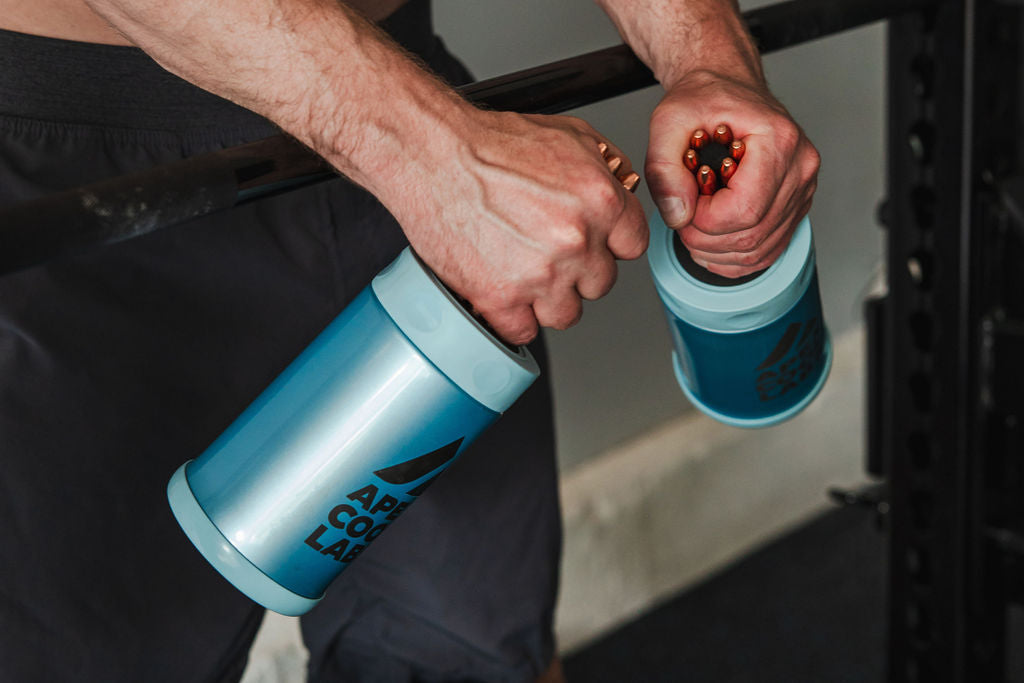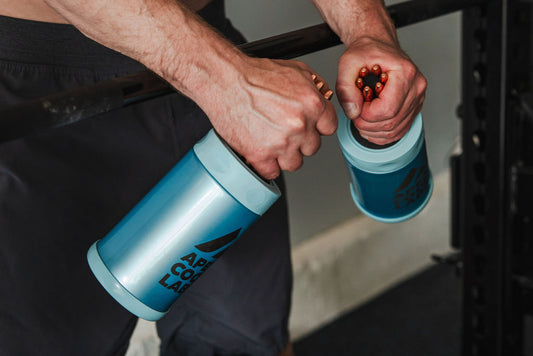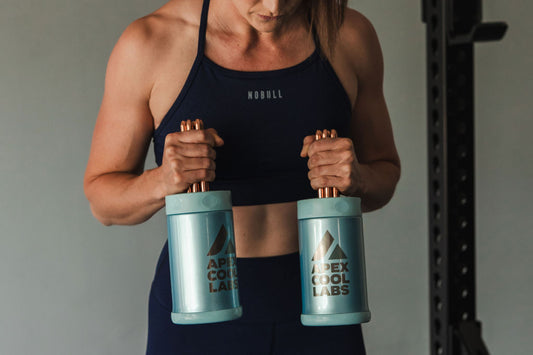You’ve read the science-backed evidence for palm cooling. You’re hungry for those incredible results. Now, you’re wondering how to incorporate palm cooling into your training.
You’ve come to the right place!
Palm cooling is a technique for increasing training volume, gaining strength faster, and accelerating recovery during athletic endeavors. As long as you have at least 90 seconds, ideally 2-3 minutes to rest, palm cooling is easy to add into your program.
Let’s explore a few options.
Sprint or Interval Training
Palm cooling is an effective way to bring down your heart rate faster and approach each sprint fresher than you would without cooling. In one study, researchers also showed that blood lactate levels were lower when participants cooled their palms during an intense rowing interval workout.
VO2 Max Training
4 Rounds
4 minutes of hard effort (run, row, bike, etc.)
3 minutes of palm cooling rest
High Intensity Interval Training (HIIT)
2 Rounds
4 to 6 sets of 30 seconds all out sprint (run, row, bike, etc.) followed by 30 seconds active rest
3-5 minutes of palm cooling rest between rounds
Muscle Endurance
Palm cooling helps you significantly increase your muscle endurance fast - even if you have plateaued. Try it with pull-ups, dips, or push-ups.
Fatigue won’t set in as quickly after your first set. You will be able to do more sets with more reps per set than you could without cooling.
In studies, and our own training, 8-10 sets of max reps with 2.5 to 3 minutes of cooling between sets works well for increasing both top set reps and overall volume. Our customers report volume gains of 35-67% over 6-8 weeks. The extra volume is a significant contributing factor in achieving these results, but if 8 sets is too daunting, you should still see solid improvement with 6 sets.
Bodyweight Exercise Endurance
Pick one bodyweight movement you want to improve
Frequency: Once per week
Sets: 8-10
Reps per Set: As many reps as possible (AMRAP)
Palm Cooling Rest Between Sets: 2.5-3 minutes
Volume Training
If you are trying to increase your volume (number of reps at a given weight) on a given lift, palm cooling will change the game!
In this Stanford study, trained participants did 6 sets of max rep bench press at 50% of their one rep max (1RM). The group that used palm cooling saw a 37% increase in total volume in just 5 sessions, compared to the non-cooling group which increased by 13%.
This finding has exciting implications for Combine training, CrossFit competitors, and bodybuilders.
Similar to bodyweight exercises, we’ve found that the magic happens in those extra sets you can tack on every session.
Bench Press Volume
Frequency: Once per week
Sets: 6-8 sets
Load: 50-75% of your 1RM
Reps per Set: AMRAP
Palm Cooling Rest Between Sets: 2.5-3 minutes
Strength Training
In peer-reviewed research, trained individuals improved their bench press strength by 22% over six weeks. They performed a bench pyramid twice per week. In our own training, we have experienced similar results over 6-8 weeks.
People report feeling fresh even as they progress deep into their working sets. Try incorporating cooling during your regular rest when doing compound lifts like squatting, shoulder pressing, benching, and deadlifting.
Palm Cooling Bench Press Pyramid
This protocol is the program used in the study. Participants were bench-press trained and had plateaued their bench strength. They completed the pyramid twice per week. Successful completion of the 2 reps in Set 4 resulted in an increase in the weights used in all 6 sets by 2.7 kg (~6 pounds) in the subsequent workout.
Set 1: 10 reps at 40%
Set 2: 7 reps at 60%
Set 3:4 reps at 80%
Set 4: 2 reps at 95%
Set 5: 5 reps at 60%
Set 6: 10 reps at 40%
Given that women can typically handle greater volume closer to their maximum weight, we believe this pyramid could be modified for female lifters as follows:
Set 1: 10 reps at 50%
Set 2: 7 reps at 70%
Set 3: 4 reps at 90%
Set 4: 2 reps at 97%
Set 5: 5 reps at 70%
Set 6: 10 reps at 50%
In-Game Recovery
In many sports, athletes have short breaks to recover. These are ideal moments for palm cooling. Athletes will notice that they can compete at higher intensities for longer periods because their heart rate drops faster, they may experience less perspiration (preventing water and electrolyte loss), and they will return to the court, ice, or field with more energy.
Palm cooling is perfect for in-game recovery for basketball, volleyball, hockey, football, lacrosse… anytime an athlete has 90 seconds or more to cool.
In this video, Austin Einhorn, founder of Apiros and expert in sports and human movement, discusses two specific use cases for palm cooling with athletes: tendon health and in-competition recovery.
Climbing & Bouldering
Climbing and bouldering are unique sports where palm cooling is well suited to improve recovery between routes or problems. In this Instagram post, Eric Hörst, performance climbing coach, talks about the positive impact the Narwhals have had on his high intensity work such as during 4 x 4 sessions. Many of the early adopters of the Narwhals are climbers and boulderers who have reported the same impact!
4x4 Bouldering Circuits
For those less familiar, 4x4 bouldering circuits consist of doing 4 boulder problems in a row with no rest in between problems, resting, and then repeating the same 4 problems for a total of 4 sets. The nuances of such a circuit can vary, but a classic version involves choosing 4 longer bouldering problems (involving multiple moves) of slightly decreasing difficulty, so the first problem is the steepest and most challenging, and the next 3 decrease in difficulty and steepness. A classic climb-to-rest ratio of 1:2 is often used in the circuit. Typically climbers will be resting 4 or more minutes between each repetition of the circuit, making palm cooling an ideal fit for boosting recovery during the rest period.
Sport Climbing
For sport climbing in a gym setting, palm cooling also offers an incredible “depumpifying” effect! Although not yet formally studied, we have seen many climbers recover faster after climbs with a high pump-quotient, allowing quicker repetitions of hard routes. For a very deep forearm pump, we recommend palm cooling for even longer than 3 minutes if possible.
Downregulation
Sports science professionals are increasingly recommending protocols to help us recover better after exercise or competition. Often referred to as downregulation, the goal is to accelerate our body’s transition from the sympathetic (fight or flight) to the parasympathetic (rest and digest) system. By reactivating the parasympathetic system faster, the understanding is that we are able to jump start the recovery process that lasts 24-48 hours post exercise.
This study showed that immersing your head in water immediately triggers post-exercise parasympathetic activity, with colder immersion temperatures (14-15°C or 57-59°F) likely to be most effective. Hat tip to Kevin Neeld, PhD for summarizing the study!
We found it interesting that this temperature (14-15°C) is within the range for effective palm cooling (10-15°C) and that the face - specifically the cheeks - contains the same glabrous skin found in our palms.
To be clear, we are unaware of any studies on palm cooling and downregulation, but given the role of heart rate recovery and thermoregulation in post exercise reactivation of the parasympathetic system, it seems the two could go “hand in hand”.
Post-Exercise Recovery
A common technique for downregulation is to perform controlled breathing exercises for 3 to 5 minutes (i.e. box breathing or cyclic sighing) while lying down.
We’ve been incorporating palm cooling during this type of protocol in our training by holding on to the Narwhals while focusing on our breathing.
These examples demonstrate just a few of the ways to incorporate palm cooling into your training. As the protocol becomes more widely used, more use cases for palm cooling will emerge. We are particularly excited to continue learning and experimenting with how palm cooling can enable novel training methods and improve results for competitive and everyday athletes.



